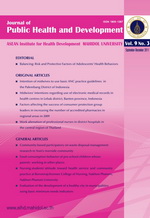Evaluation of the development of a healthy city in municipalities using basic minimum needs indicators
Main Article Content
Abstract
The objectives of this study were to: 1) compare the results for the healthy city
development process of municipalities that had met and those that had not yet met the
healthy city process criteria of the Department of Health (DOH), Ministry of Public
Health, by using the Basic Minimum Needs (BMN) indicators, and 2) study the
relationship between the ability to meet the healthy city process criteria and the ability to
meet the BMN indicators. This was a cross-sectional analytical study with a sample size
of 136 municipalities that had met the healthy city process criteria and 76 municipalities
that had not yet met the healthy city process criteria. The BMN data present 42 indicators
for quality of life in six categories. The data were classified in terms of average success
rate and number of BMN indicators accomplished and were analyzed using descriptive
and inferential statistics such as the Mann-Whitney U test and Chi-Square Test.
The results revealed that the municipalities that had met the healthy city process criteria
were not more likely to have an average success rate (neither for individual categories
nor the total for BMN indicators) than were the municipalities that had not yet met the
healthy city process criteria, and there was not a significant relationship between the
ability to meet the healthy city process criteria and the ability to meet the BMN
indicators. These results indicate that the DOH healthy city process did not apparently affect
the favorable results for the BMN indicators of the municipalities due to the existence of
other development processes with other health partners that also support the development
of the healthy city concept. Thus, integration of processes by municipalities is required.
development process of municipalities that had met and those that had not yet met the
healthy city process criteria of the Department of Health (DOH), Ministry of Public
Health, by using the Basic Minimum Needs (BMN) indicators, and 2) study the
relationship between the ability to meet the healthy city process criteria and the ability to
meet the BMN indicators. This was a cross-sectional analytical study with a sample size
of 136 municipalities that had met the healthy city process criteria and 76 municipalities
that had not yet met the healthy city process criteria. The BMN data present 42 indicators
for quality of life in six categories. The data were classified in terms of average success
rate and number of BMN indicators accomplished and were analyzed using descriptive
and inferential statistics such as the Mann-Whitney U test and Chi-Square Test.
The results revealed that the municipalities that had met the healthy city process criteria
were not more likely to have an average success rate (neither for individual categories
nor the total for BMN indicators) than were the municipalities that had not yet met the
healthy city process criteria, and there was not a significant relationship between the
ability to meet the healthy city process criteria and the ability to meet the BMN
indicators. These results indicate that the DOH healthy city process did not apparently affect
the favorable results for the BMN indicators of the municipalities due to the existence of
other development processes with other health partners that also support the development
of the healthy city concept. Thus, integration of processes by municipalities is required.
Article Details
How to Cite
1.
JPHD A. Evaluation of the development of a healthy city in municipalities using basic minimum needs indicators. J Public Hlth Dev [internet]. 2012 May 10 [cited 2025 Dec. 25];9(3):337. available from: https://he01.tci-thaijo.org/index.php/AIHD-MU/article/view/1429
Section
General Articles


